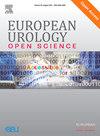Intraductal Carcinoma Predicts Poor Response to Neoadjuvant Therapy in High-risk Prostate Cancer: A Retrospective Analysis of a Prospective Trial
IF 4.5
3区 医学
Q1 UROLOGY & NEPHROLOGY
引用次数: 0
Abstract
Background and objective
High-risk localized prostate cancer (PCa) patients may require neoadjuvant treatment (androgen deprivation therapy [ADT] plus abiraterone with or without taxane-based chemotherapy) before radical prostatectomy (RP). Intraductal carcinoma of the prostate (IDC) is an aggressive histological variant of prostate adenocarcinoma. This study aims to evaluate the association of IDC on biopsy with pathological response in such PCa patients.
Methods
A retrospective analysis was conducted using the prospective trial data from 75 patients with high-risk localized/locally advanced PCa treated with 24 wk of neoadjuvant therapy comprising ADT and abiraterone, with or without taxane-based chemotherapy, followed by RP. Pathological responses, including pathological complete response (pCR), minimal residual disease (MRD), and adverse pathology outcomes (ypN1 or ≥ypT3b), were analyzed. Multivariable logistic regression identified the predictors of poor pathological response.
Key findings and limitations
Among 75 patients, 35 (47%) had IDC on biopsy. Patients with IDC had worse pathological outcomes: 32 of 35 (91%) failed to achieve a favorable response (pCR or MRD) compared with 26 of 40 (65%) in those without IDC. IDC was also associated with higher rates of adverse pathology at RP, occurring in 27 of 35 patients (77%) versus nine of 40 patients (22%) without IDC. IDC independently predicted poor response (odds ratio 6.18, 95% confidence interval 1.16–32.8; p = 0.032) after adjusting for tumor volume, Gleason grade, and prostate-specific antigen (PSA). In contrast, cribriform (Crib) pattern at biopsy did not impact response significantly. Metastatic progression and survival data were unavailable.
Conclusions and clinical implications
IDC, but not Crib, on biopsy predicts poor pathological response to neoadjuvant therapy (ADT plus abiraterone with or without taxane-based chemotherapy) in high-risk PCa after adjusting for tumor volume and PSA. An understanding of this treatment-resistant phenotype will improve PCa biology insights and guide novel therapeutic strategies.
Patient summary
Intraductal carcinoma (IDC) is a more aggressive form of prostate cancer that does not respond well to treatment. In our study, we found that 91% of patients who had IDC detected in their biopsy before surgery did not show a good response to presurgery therapy.
导管内癌预测高危前列腺癌对新辅助治疗的不良反应:一项前瞻性试验的回顾性分析
背景与目的高危局限性前列腺癌(PCa)患者在根治性前列腺切除术(RP)前可能需要新辅助治疗(雄激素剥夺治疗[ADT] +阿比特龙加或不加紫杉烷化疗)。前列腺导管内癌(IDC)是一种侵袭性前列腺腺癌的组织学变异。本研究旨在评估活检IDC与此类PCa患者病理反应的关系。方法回顾性分析75例高风险局部/局部晚期PCa患者的前瞻性试验数据,这些患者接受了24周的新辅助治疗,包括ADT和阿比特龙,加或不加紫杉烷化疗,然后进行RP。分析病理反应,包括病理完全缓解(pCR)、最小残留病(MRD)和不良病理结果(ypN1或≥ypT3b)。多变量逻辑回归确定了不良病理反应的预测因素。75例患者中,35例(47%)活检显示IDC。IDC患者的病理结果更差:35名患者中有32名(91%)未能获得良好的反应(pCR或MRD),而40名未患IDC的患者中有26名(65%)未能获得良好的反应。IDC也与RP的较高不良病理发生率相关,35例患者中有27例(77%)发生,而40例未发生IDC的患者中有9例(22%)发生。在调整肿瘤体积、Gleason分级和前列腺特异性抗原(PSA)后,IDC独立预测不良反应(优势比6.18,95%可信区间1.16-32.8;p = 0.032)。相反,活检时筛状(Crib)模式对反应没有显著影响。转移进展和生存数据无法获得。结论和临床意义:在调整肿瘤体积和PSA后,活检中的sidc(而非Crib)预测高危PCa患者对新辅助治疗(ADT +阿比龙加或不加紫杉烷化疗)的不良病理反应。对这种治疗抗性表型的理解将提高前列腺癌生物学的见解和指导新的治疗策略。导管内癌(IDC)是一种侵袭性较强的前列腺癌,治疗效果不佳。在我们的研究中,我们发现91%在手术前活检中检测到IDC的患者对手术治疗没有很好的反应。
本文章由计算机程序翻译,如有差异,请以英文原文为准。
求助全文
约1分钟内获得全文
求助全文
来源期刊

European Urology Open Science
UROLOGY & NEPHROLOGY-
CiteScore
3.40
自引率
4.00%
发文量
1183
审稿时长
49 days
 求助内容:
求助内容: 应助结果提醒方式:
应助结果提醒方式:


